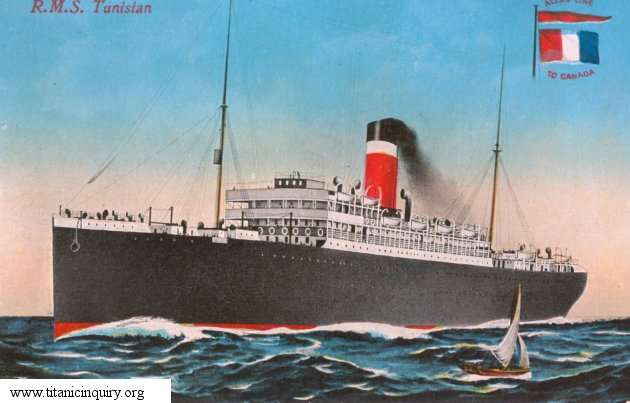The Tunisian – British Home Child Ship – Ships They Came On
Built in Glasgow, the Allan Line’s Tunisian made her maiden voyage in 1900 travelling from Liverpool to Halifax and Portland, Maine. A month later, her first of many trips to Quebec, Montreal, Halifax and Portland began. Over a period of 21 years, she carried over 2,000 British Home Children to their destinations in Canada.
The Tunisian boasted refrigeration, good heating and ventilation. It also had hot and cold, fresh and salt water on tap and four-birth emigrant cabins with spring mattresses.
In 1912, five days before the Titanic sank, the Tunisian reported heavy ice in the area that was to become the site of the disaster. The Tunisian was travelling eastbound at this time from St. John, New Brunswick to Liverpool.
The Tunisian’s most noteworthy trip however was on Oct. 3, 1914 when she was part of the 1st Canadian Division, Canadian Expeditionary Force convoy that included seven warship escorts and 32 transport ships. The Troopships were divided into three columns. The Tunisian was in the middle and transported HQ staff (1st CIB), 3rd Battalion (Toronto), 1st CIB and #3 Field Ambulance for a total of 1,412 troops. She also carried 37,086 sacks of flour.
Rear-Admiral Hugh Pullen, RCN spoke about the operation: “The total figures for the First Contingent are well worth remembering: 1,547 officers, 29,070 men, 7,679 horses, 70 guns, 110 motor vehicles, 705 horsed vehicles and 82 bicycles – a most impressive force for any small nation to raise in less than two months. They were all volunteers and worthy representatives of Canada. I trust that the spirit that inspired them still burns in their grandsons.”
In 1915, she served for some time as a German POW accommodation ship at the Isle of Wight and then was used further as a troop carrier. 1917 saw her ownership passed over to the Canadian Pacific along with the Allan line itself. CP Ships was a large Canadian shipping company established in the 19th century. From the late 1880s until after World War II, the company was Canada’s largest operator of Atlantic and Pacific steamships.
In 1920, Tunisian was changed to cabins and third class accommodation (310-cabin and 736-3rd class passengers), converted to oil fuel in 1921 – and in 1922 was renamed Marburn. She remained in service until 1927, sailing from Liverpool, Glasgow, Hamburg, Antwerp and London at various times. She made her final transatlantic sailing, from Antwerp to St. John, New Brunswick, in April 1928, and was scrapped that fall.
